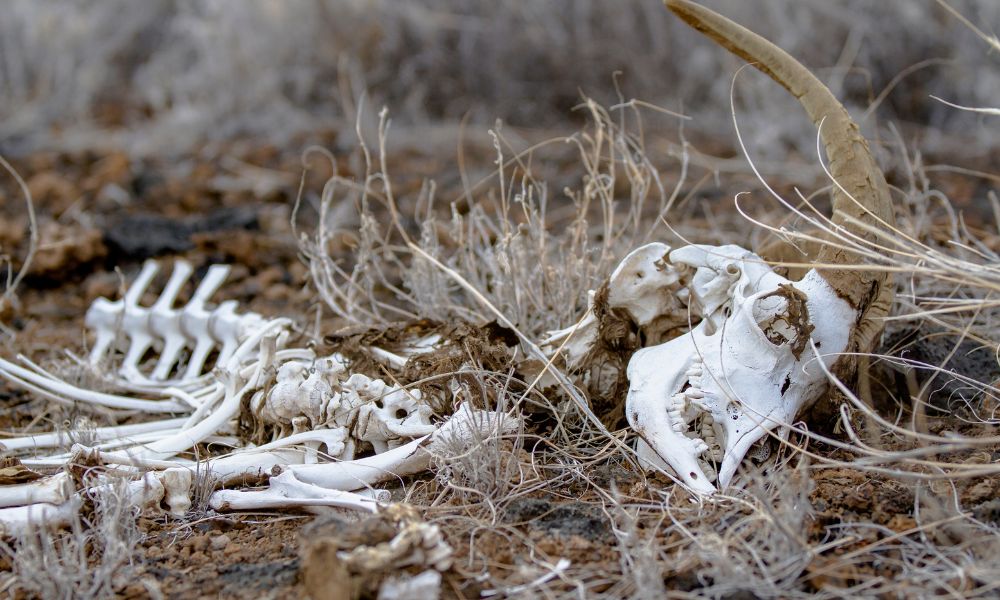Goat skeletons are in many ways like our own, then.
Our own mature skeleton is made up of about 206 bones, so not very many more than a goat’s, and it develops in a similar way.
Let’s look further into this.

How many bones does a baby goat have?
The first thing to say is that goats certainly have more bones than mature goats—how many, though, is always up for some degree of slight variation.
It won’t be precisely the same for every goat.
This is due to a wide variety of slight mutations or genetic traits passed down from parents.
There are many, many breeds of goat across the world, and this has naturally led to a great deal of variation in numbers.
However, there is far less difference between an adult and a baby goat than there is between an adult human and an infant.
While we are both mammals with fundamentally similar skeletons, a baby goat’s skeleton needs to be ready to support the kid’s weight almost immediately.
They begin walking very shortly after being born, so they naturally need stronger bones right away.
A baby goat might have 200-210 bones.
A human baby might have 300, which will eventually come down to around 206.
So, as you can see, there is far less bone fusing in goats than in humans.
Let’s compare with an adult, now.
How many bones does an adult goat have?
Adult goats have around 189 bones on average.
In many cases, babies will be born with their skeletons more or less fully formed, meaning that an adult and a juvenile might have the same number of bones.
Again, though, don’t forget the degree of variation within the species. Individuals can have different amounts of bones, so an adult may have more or fewer than 189.
There isn’t much ‘logic’ to it, as such, in the sense that you don’t necessarily find, say, mountain goats with fewer and stronger bones than a goat that roams flat plains.
As I said, it’s mostly down to genetics and mutations.
What is important to know, however, is that like ours, a goat’s skeleton is made up of two fundamental parts.
What are the components of a goat skeleton?
Much like our own, the bones of a goat can be split into two categories.
You might say a goat’s skeleton has two components.
These are the axial skeleton and the appendicular skeleton.
The axial could be considered the upper or top section of the goat’s skeleton, composed of its skull, vertebrae, ribs and sternum.
The skull is not one bone, but in fact many fused together by sutures.
This is the axial skeleton.
The appendicular skeleton comprises the goat’s limbs or extremities.
The hindlimbs and the forelimbs.
This is fundamentally the same as our own skeleton.
It is made up of two parts, that are essentially upper and lower parts of the skeleton.
There is some overlap, of course, but fundamentally evolutionary biology shows that mammal skeletons are simply the same piece of hardware doing the same job fitted to any size or shape!
Is there any variation between genders, then?
How many bones does a male goat have?
A male goat has on average the same 189 bones as we mentioned earlier.
Again, while there is always the chance that any individual has more or fewer than this, the average male goat will fall somewhere within this category.
Is this any different for females?
How many bones does a female goat have?
Females actually do not have a different number of bones in a fully mature skeleton, barring, again, the slight variation allowed for any individual regardless of sex.
So, again, it will be somewhere around 189 bones.
The idea that males and females should have different numbers of bones, while often true for some in the animal kingdom, is actually biblical in origin.
Eve was created from Adam’s rib, granting her an extra rib where he was missing one.
This is not, however, actually true.
In most mammal species, males and females tend to have the same, if not very close, number of bones.
So, goat skeletons are interesting and, in some ways, quite unique, but for the most part, they follow the same loose structure as many mammals.
It is made up of two fundamental parts, and over time as the individual matures, bones fuse together to form a skeleton made up of fewer bones by adulthood.
Males and females have the same number of bones on average, although, as I said, there is always the chance for variation between individuals.
